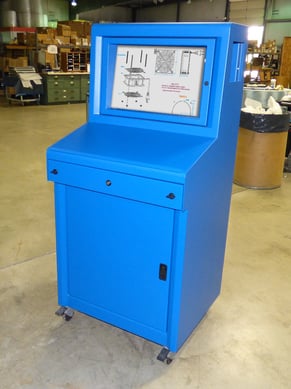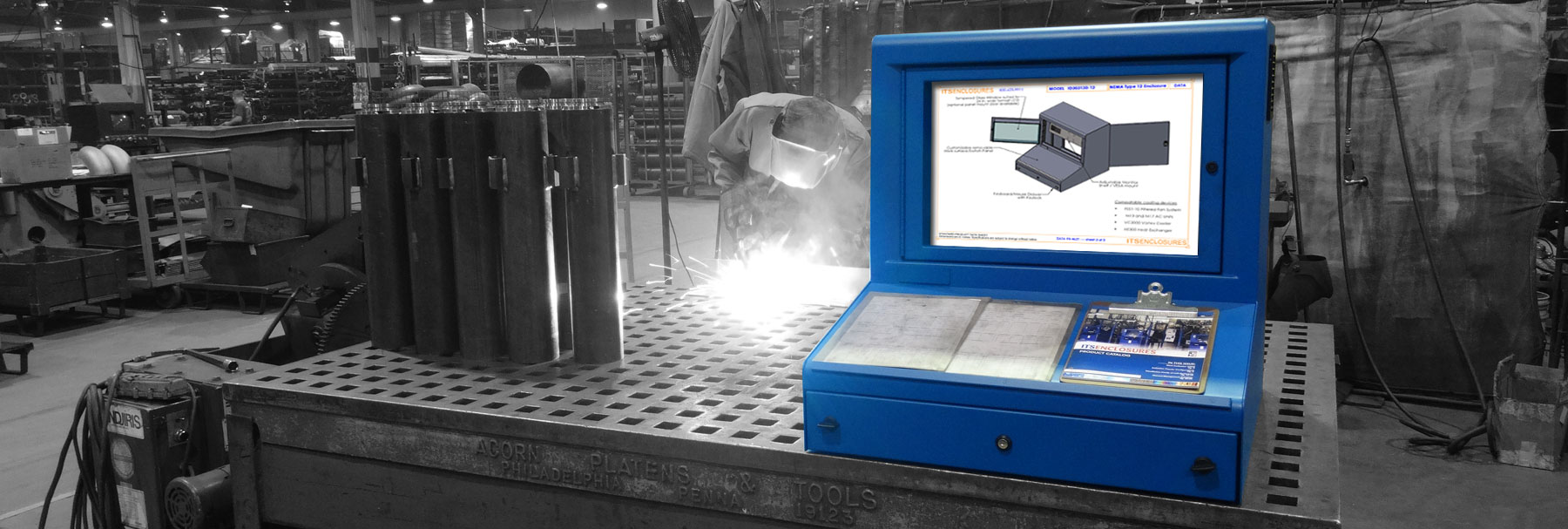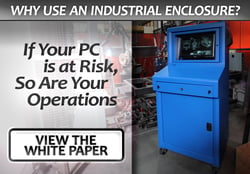A number of challenges present themselves when deploying sensitive electronics in a manufacturing setting.
Computer enclosures make for a safe, reliable way for system integrators to protect equipment. However, before agreeing upon a computer enclosure for a harsh, industrial environment, a number of significant issues should be considered. For example, what kind of material should the enclosure be made of or how many peripherals will be stored inside of the enclosure? The following 6 items should play a key role in the enclosure selection process.
6 Considerations for Specifying an Industrial Enclosure
Environment
The overall installation environment is one of the most imperative factors to consider. A factory or company that specializes in food processing or pharmaceutical applications will require a completely different solution compared to an active, automotive assembly line. Before starting a thorough search for new enclosures, one must determine the primary environmental concern – clean, sanitized area vs. greasy, dusty environment.
Application
Always consider: What is the intended purpose for the enclosure? A manufacturing assembly line may require an articulating arm solution to easily input product information. While other applications may require the enclosure to be bolted down in place for security and safety concerns. Oftentimes, it is ideal to have industrial-grade, swivel castors, so that the enclosure can be moved around the factory floor. Enclosures should also offer easy access for users, while still maintaining sufficient security.
Material
 Based on the setting/environment where the enclosure is installed will dictate the type of cabinet construction. Exposure to various chemicals and/or a heavy wash down may require the enclosure to be stainless steel. To stop bacteria from forming, an enclosure with a sloped top may also be a viable option. Whereas, a dusty, dirty, and somewhat greasy environment may be best suited for a painted steel enclosure.
Based on the setting/environment where the enclosure is installed will dictate the type of cabinet construction. Exposure to various chemicals and/or a heavy wash down may require the enclosure to be stainless steel. To stop bacteria from forming, an enclosure with a sloped top may also be a viable option. Whereas, a dusty, dirty, and somewhat greasy environment may be best suited for a painted steel enclosure.
Size
Accounting for the electronics that will be housed inside is also central in determining the size of the industrial enclosure. Adequate space must be factored in for a monitor, PC, printer, UPS, mouse, and keyboard. Electronics are ever changing, so always plan for the future. In most cases, as monitor sizes increase, the computer size will decrease.
Standards
Not all enclosures are created equal! Research which National Electrical Manufacturers Association (NEMA) rating is best suited for the potentially hazardous or contaminated environment and application. The NEMA rating will determine the computer enclosure’s ability to withstand various conditions. For example, a NEMA 4X enclosure will protect against hose directed water, dust, dirt, splashing fluids, and corrosive materials.
Thermal Management
Lastly, the correct thermal management will maximize the lifetime of the electronics that are being protected within the enclosure. Some settings are too humid, while others may be far too cold. Determining the proper cooling and/or heating is based on a number of factors and information, including enclosure size, heat given off by the peripherals, enclosure material and external or ambient temperatures. Thermal management can be as simple as a filtered fan system. Other applications may require an air conditioner or heat exchanger. Energy efficiency can also factor into the overall decision on what kind of thermal management to use. Do not forget the importance of a thermostat to regulate temperatures!
The correct computer enclosures will continuously protect the life span of a PC and other electronics from dirt, dust, humidity, particulate-laden air, liquids and corrosive materials. In the manufacturing sector, time is money. It is essential to maintain and keep computer systems up and running for as long as possible. The right enclosure for the job will save time and money.
HAVE QUESTIONS? LET US KNOW HOW WE CAN BEST ASSIST YOU! CONTACT AN 'ITSENCLOSURES EXPERT' AT 1-800-423-9911 -OR- SEND US AN EMAIL: INFO@ITSENCLOSURES.COM





